11 Best Open-Source Database Software In 2023

[ad_1]
Welcome to our in-depth exploration of the best dynamic and evolving open-source database software.
Besides listing the best tools, we’re also diving deep into their core features, strengths, and how they fit the diverse needs of businesses and individual developers.
Whether you’re an advanced user or a beginner, you’re in the right place.
From well-established giants like MySQL and PostgreSQL to newer, innovative contenders, we’ll cover a spectrum that caters to all expertise and needs.
We’ve tailored this article to shed light on the complex details that make each software unique so that you can make an informed choice for your next big project.
Let’s unlock the potential of open-source databases together.
This post covers:
The Best Open-Source Database Software
Choosing the right open-source database software can make or break your experience.
Ensuring it meets your unique project demands and provides a seamless and empowering experience is essential.
You need a solution that keeps pace with your project!
Look for essential features like scalability to accommodate growth, reliability to avoid unexpected downtimes, and a robust community for support and guidance.
Our list caters to various needs, whether handling extensive data, developing applications, or exploring coding possibilities.
1. MySQL
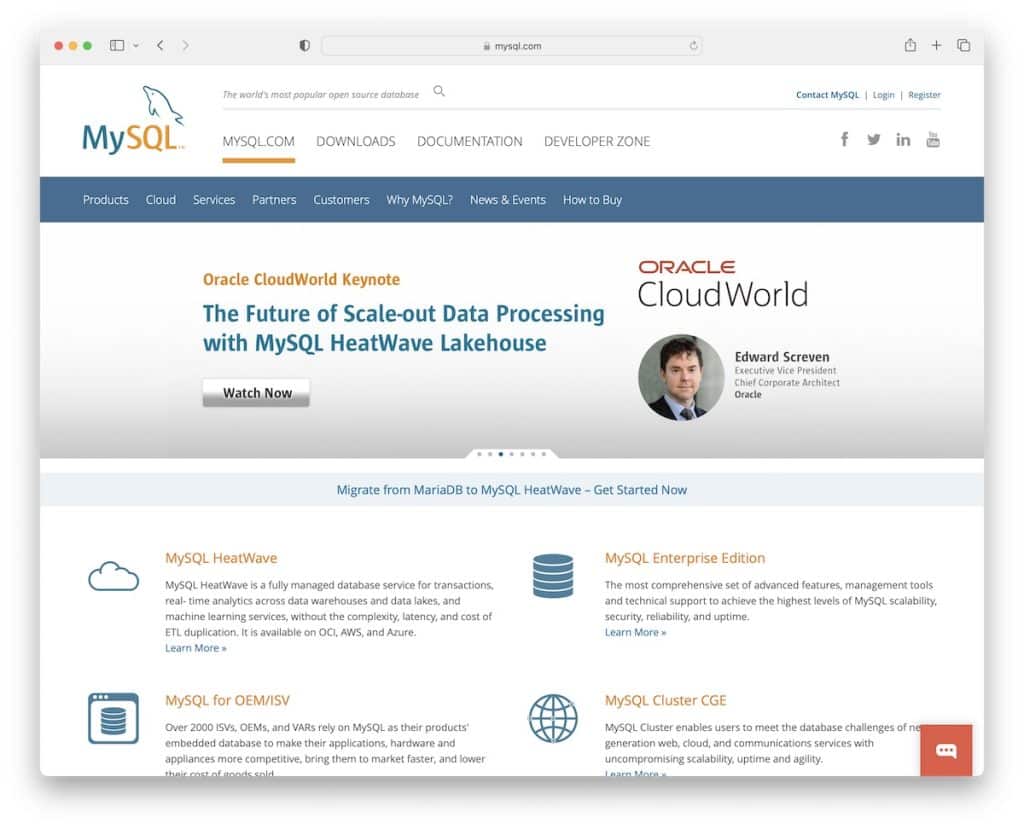
MySQL is incredibly user-friendly, making it a go-to choice for beginners and seasoned pros. It’s great for handling all your data needs, big or small.
With its remarkable speed and efficiency, MySQL ensures your applications run smoothly, even when dealing with large volumes of data.
What truly sets MySQL apart is its versatility.
Whether you’re building a small blog or a large eCommerce site, MySQL adapts like a chameleon to your project’s needs. It’s also remarkably secure, offering robust features to protect your data from prying eyes.
Plus, the community support is fantastic. You’ll find a wealth of resources and a friendly bunch of fellow MySQL users ready to help you with tips and tricks.
MySQL combines ease of use, flexibility, and robust security, making it a top-notch choice for your database needs.
Key Features of MySQL:
- It has a straightforward and intuitive interface, accessible for beginners while still powerful enough for advanced users.
- Fast data processing and high reliability ensure efficient handling of large databases and transaction processing.
- It runs on various platforms, including Windows, Linux, and macOS, offering flexibility in different computing environments.
- Multiple storage engines to choose the best solution based on your specific requirements, such as transactional or non-transactional environments.
Best for:MySQL is a top choice for many users, from web developers and startups to large enterprises, due to its ease of use, reliability, and scalability. Dynamic websites and applications are a perfect fit because of the efficient, secure, and high-performing data management solutions.
Pricing: MySQL is free and open-source.
Get MySQL
2. MariaDB
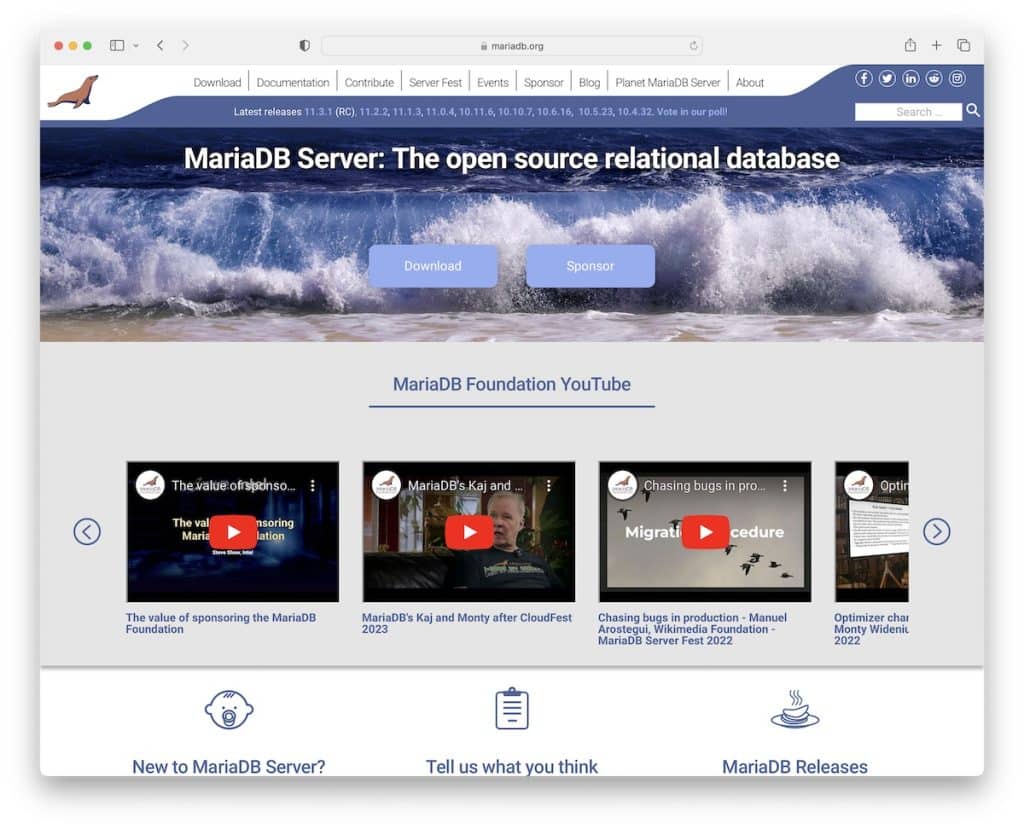
With its high-performance storage engines, MariaDB is like a sports car in the world of databases, zipping through data operations with incredible speed.
Growing business? No problem!
MariaDB scales smoothly, easily handling large volumes of data for businesses on the rise. Security-wise, it’s like a fortress, fortified with encryption, user authentication, and access control, keeping your data safe and sound.
MariaDB is fully compatible with MySQL, making the switch as smooth as silk. Whether it’s synchronous or asynchronous replication, MariaDB has your back, ensuring high availability and aiding in disaster recovery.
MariaDB is a dream come true for those venturing into modern web applications, supporting NoSQL databases and JSON, facilitating flexible data modeling and quick queries.
Plus, its multi-version concurrency control (MVCC) lets multiple transactions coexist peacefully, ensuring efficiency and stability.
MariaDB is versatile, robust, and ready for any challenge.
Key Features of MariaDB:
- It is equipped with advanced storage engines, like Aria, InnoDB, and TokuDB, enhancing its performance and speed in processing data.
- Highly scalable due to the efficient handling of large volumes of data.
- MariaDB incorporates robust security measures, including encryption, user authentication, role-based access control, and SQL injection prevention to ensure data protection.
- It uses MVCC to ensure multiple transactions can co-occur without interfering with each other.
Best for:MariaDB is ideal for businesses and developers seeking a high-performance, scalable, and secure database solution, especially those looking to migrate from MySQL due to its compatibility.
Pricing: MariaDB is free and open-source.
Get MariaDB
3. PostgreSQL
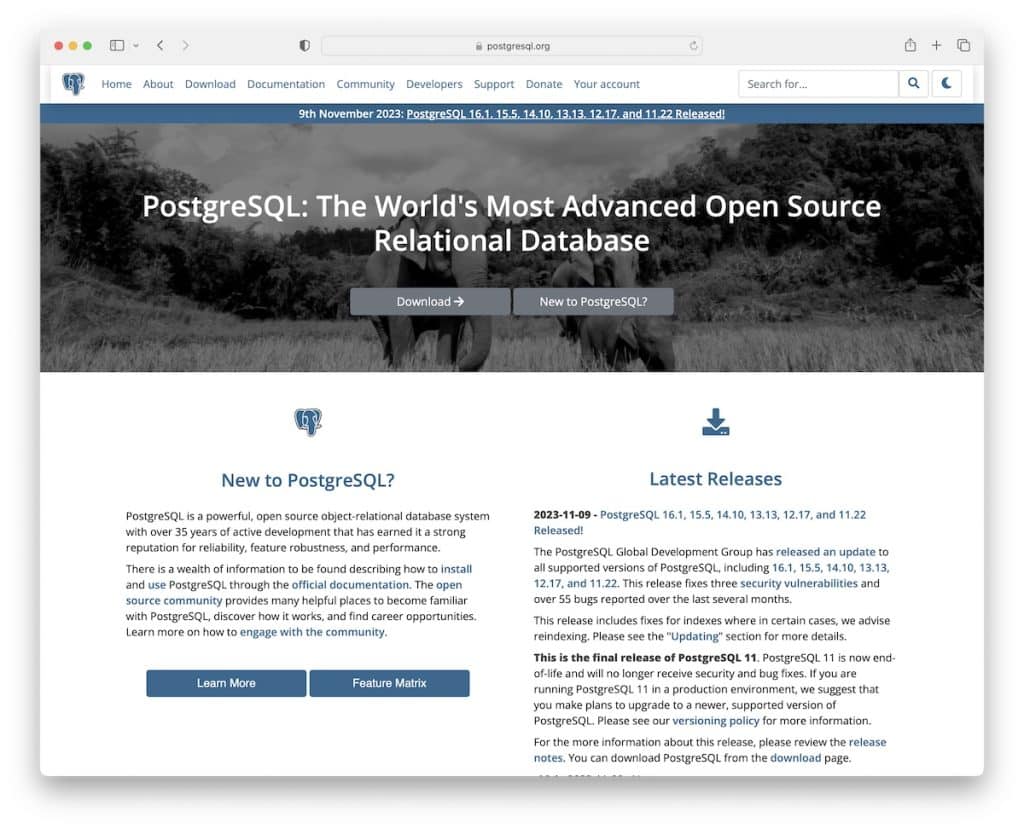
PostgreSQL is renowned for its advanced data management capabilities and reliability.
But here’s where PostgreSQL truly shines: Its extensibility. You can tailor it to your heart’s content, creating custom data types, operators, and functions.
When organizing and retrieving data, PostgreSQL is a master with its various indexing techniques, including B-tree and GIN, ensuring lightning-fast queries.
Concurrency? Easy!
MVCC means multiple users can access the same data without stepping on each other’s toes. And for those who can’t afford downtime, PostgreSQL’s replication capabilities offer peace of mind with both asynchronous and synchronous options.
Don’t forget its full-text search engine and JSON support, making working with complex, unstructured data a breeze.
Want to connect with external data sources? PostgreSQL’s foreign data wrappers seamlessly bridge your database with the outside world.
With robust security features like SSL encryption and role-based access control, plus its ability to handle massive data volumes and transaction loads, PostgreSQL is a dream for enterprise-level applications.
Key Features of PostgreSQL:
- It ensures that all database transactions are atomic, consistent, isolated, and durable, maintaining data integrity and reliability.
- Users can define their own data types, operators, and functions. This allows customization and flexibility to meet specific application needs.
- It includes a powerful full-text search capability with advanced features like text indexing, stemming, ranking, and phrase search, facilitating complex text-based queries.
- PostgreSQL allows users to access data stored in external databases or file systems using foreign data wrappers.
Best for:
PostgreSQL is perfect for enterprises and developers who need a robust, scalable database for complex and high-volume data handling. Its advanced features and reliability make it an excellent choice for critical applications and sophisticated data workloads.
Pricing: PostgreSQL is free and open-source.
Get PostgreSQL
4. Redis
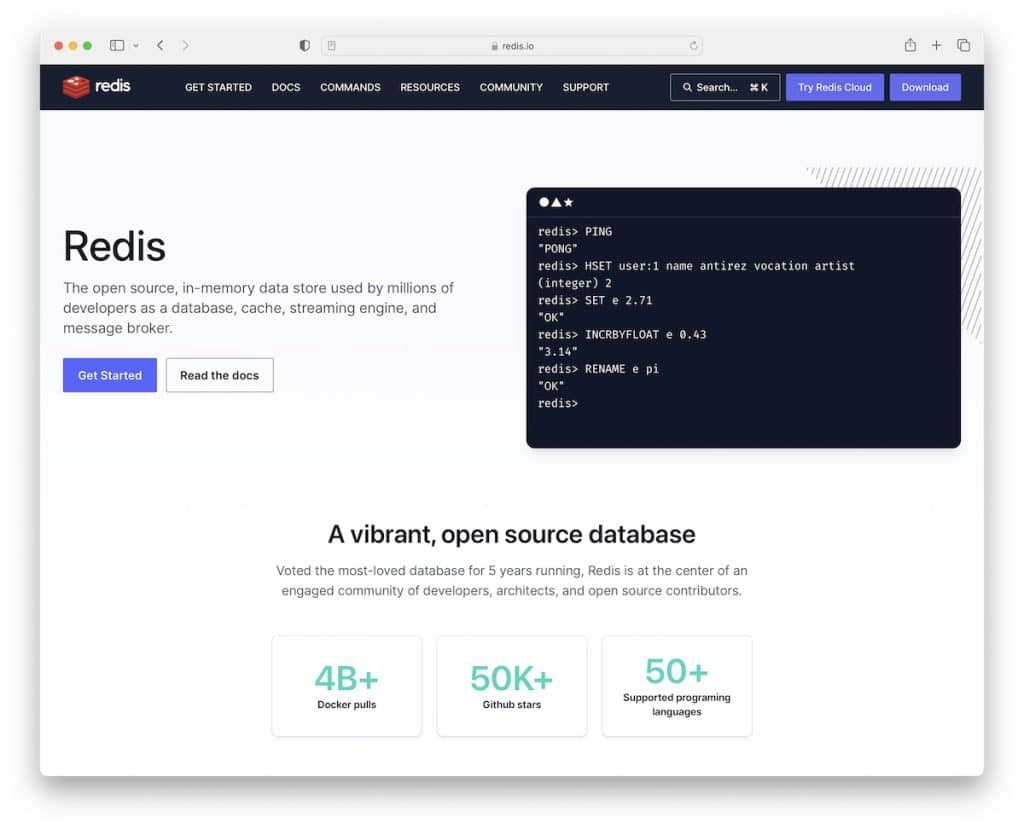
Redis stands out as a “data structure server,” supporting structures like strings, hashes, lists, sets, and more.
What’s really cool about Redis is its programmability.
You can customize server-side scripts in Lua for your specific needs.
Redis also offers impressive extensibility. With its module API, you can build custom extensions in C, C++, or Rust, allowing you to expand your capabilities.
Moreover, Redis keeps your data in memory for speedy access, yet it can also save everything to disk. Hey, you don’t want to lose your data in case of a reboot or system failure.
For scalability, Redis has you covered with its clustering capabilities. It can scale to millions of nodes, adjusting automatically as your needs grow. As for high availability, Redis ensures your data is always accessible, with replication and automatic failover.
In short, Redis is fast, flexible, and always ready for action.
Key Features of Redis:
- It supports structures like strings, hashes, lists, sets, streams, and more for efficient data manipulation and storage.
- Redis provides options to persist data to disk, ensuring data durability and protection against losses during reboots or system failures.
- It offers replication with automatic failover, ensuring data availability and reliability across standalone and clustered deployments.
- High performance and speed are especially beneficial for applications requiring rapid data access and real-time processing.
Best for:
Redis is for developers and businesses needing fast, in-memory data processing for real-time applications, like caching and session storage, particularly in high-traffic scenarios like gaming and web services. Its speed and flexibility make it a top choice for performance-driving environments.
Pricing: Redis is free and open-source.
Get Redis
5. SQLite
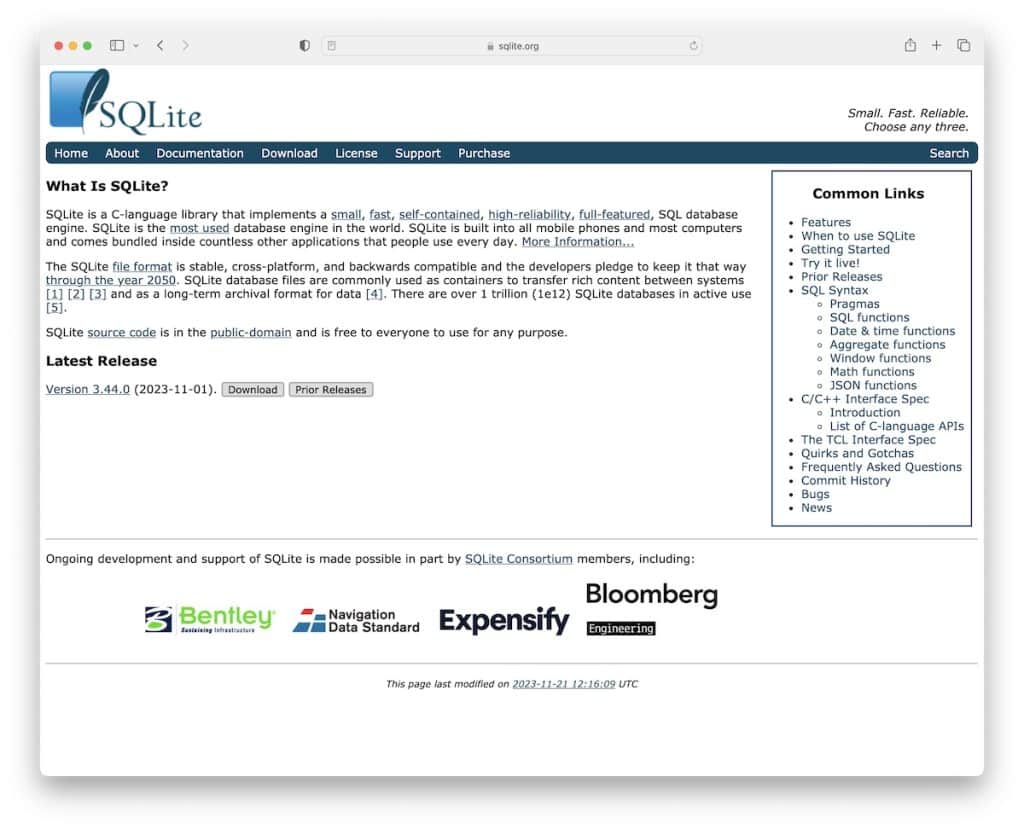
SQLite is a fantastic open-source database software for your data – a self-contained, serverless wonder about making your life easier.
It effortlessly blends into any environment, from commercial to private use. SQLite’s charm lies in its simplicity: no complicated server setups, just a straightforward, transactional SQL database engine.
Plus, it’s as portable as it gets – a single disk file contains your entire SQL database, readable across various platforms, making it a tech nomad’s dream.
What really sets SQLite apart is its compactness. It packages all its features surprisingly small, perfect for low-memory environments. But SQLite doesn’t skimp on performance despite its size, often outpacing traditional file system I/O.
And let’s talk reliability: SQLite is extensively tested to ensure it stands firm even during system crashes or power failures. It’s backed by a dedicated team of international developers, constantly enhancing its capabilities while keeping it free and open for all.
SQLite is a commitment to simplicity, reliability, and accessibility.
Key Features of SQLite:
- SQLite doesn’t require a separate server process or system to operate. It is self-contained and runs within the application itself.
- It requires no setup or configuration, offering a plug-and-play solution for database management.
- ACID-compliant transactions ensure all database operations are performed with atomicity, consistency, isolation, and durability.
- SQLite is highly efficient in terms of disk space, with a library size that can be less than 750KiB, making it suitable for environments with limited memory.
Best for:
SQLite is best for developers who need a lightweight, easy-to-use database for applications with limited resources. This could be mobile apps and embedded systems, where a full-scale database server is unnecessary.
Pricing: SQLite is free and open-source.
Get SQLite
6. Neo4j
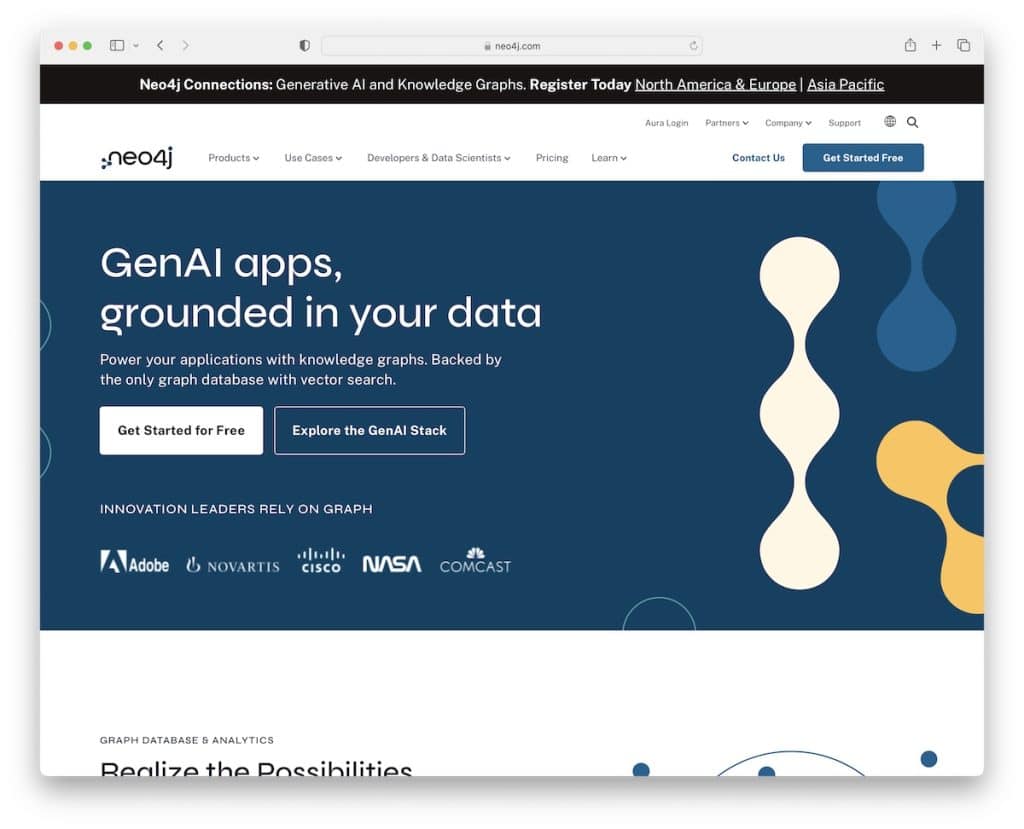
Neo4j is the graph database that’s changing the game in data management. It’s superb software for storing data and understanding and leveraging the complex relationships within it.
Neo4j is all about speed and scale, offering a fast graph database that handles even the most demanding workloads with ease.
Whether transactional or analytical queries, Neo4j delivers real-time insights from connected data, running complex queries up to 1000x faster than traditional relational databases.
With robust transactional guarantees and rigorous security features, including schema-based security and role-based access control, Neo4j offers unmatched reliability and data privacy.
Its flexible data model, intuitive tools, and support for common programming languages make building applications a breeze (happy developers).
Neo4j seamlessly integrates into your existing data ecosystem with numerous connectors and continuous release support.
Key Features of Neo4j:
- Graph database is capable of handling complex transactions and analytical workloads. (It’s ideal for mission-critical applications requiring quick data processing.)
- It provides unbounded scalability while maintaining data integrity and security.
- Neo4j supports multiple cloud options: self-hosted, hybrid, multi-cloud, or a fully managed cloud service.
- It integrates with various data platforms and applications to enhance its utility in diverse data ecosystems.
Best for:
Neo4j is ideal for developers and organizations handling complex, interconnected data, such as in social networks, recommendation systems, and fraud detection.
Pricing: Neo4j is free and open-source. But the “Enterprise Edition” is also available with pricing specific to your project needs or cloud service.
Get Neo4j
7. OrientDB
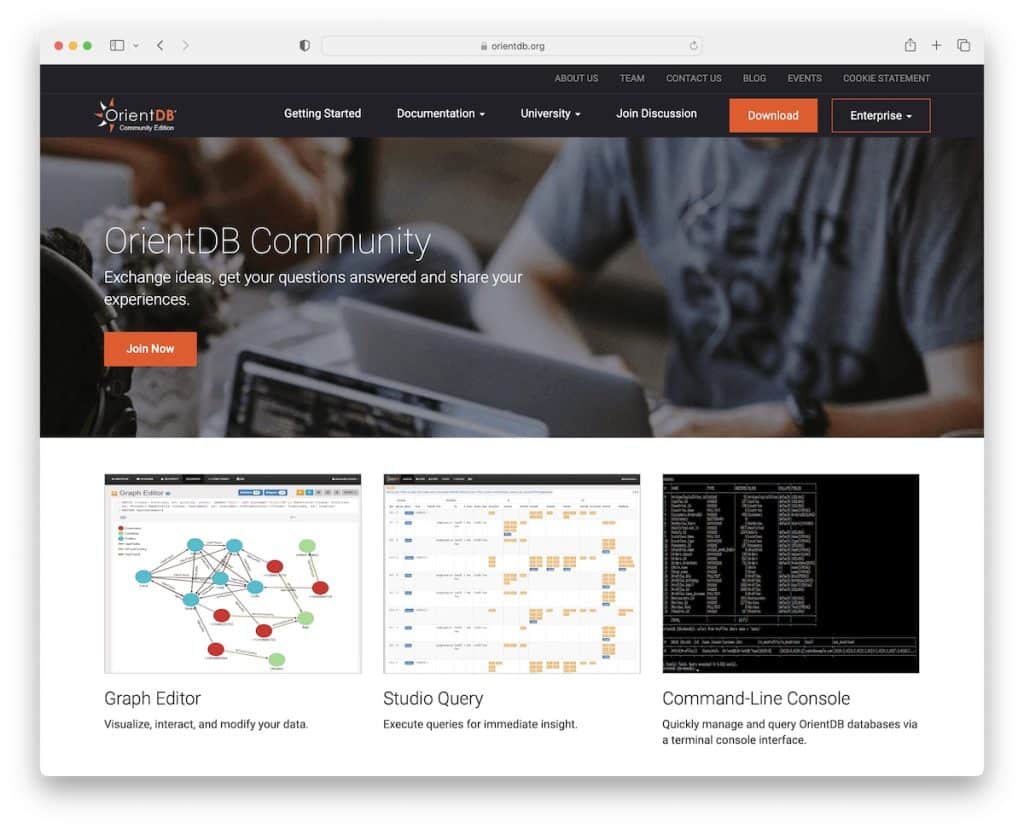
OrientDB steps up the game by breaking the traditional single-data-model mold. It responds to the diverse needs of modern data management, offering the best of both worlds – graphs and documents – to reduce operational complexity and maintain data consistency.
Speed? OrientDB has it in spades. Whether reading or writing, it handles up to 120,000 records per second. Moreover, it uses physical links for relationships, making rapid traversals through trees and graphs of records, regardless of database size.
OrientDB shines with its Enterprise Edition for large-scale needs, offering incremental backups, top-notch security, and 24/7 support, among other perks.
Its multi-master architecture is a godsend for cloud environments, promoting elastic scalability and impressive throughput without blockages.
Also, OrientDB’s low TCO, easy integration, and compatibility with multiple programming languages make it a practical choice for evolving businesses. And for those coming from other database systems, OrientDB makes transitioning a breeze with tools like OrientDB Teleporter and Neo4j Importer.
Key Features of OrientDB:
- It combines graph and document databases, offering a versatile solution that handles complex data relationships and document storage.
- OrientDB excels in read-and-write operations and can store up to 120,000 records per second.
- You can deploy OrientDB in various environments, including on-premises, cloud, and hybrid setups.
- With multi-master architecture, throughput is not limited by a single server. It allows horizontal scaling across multiple servers, enabling high throughput and fault tolerance.
Best for:
OrientDB is for developers and enterprises needing a versatile database for complex data relationships and document storage. Its multi-model capabilities and scalability make it a powerful choice for diverse and interconnected data needs.
Pricing: OrientDB is free and open-source.
Get OrientDB
8. CouchDB
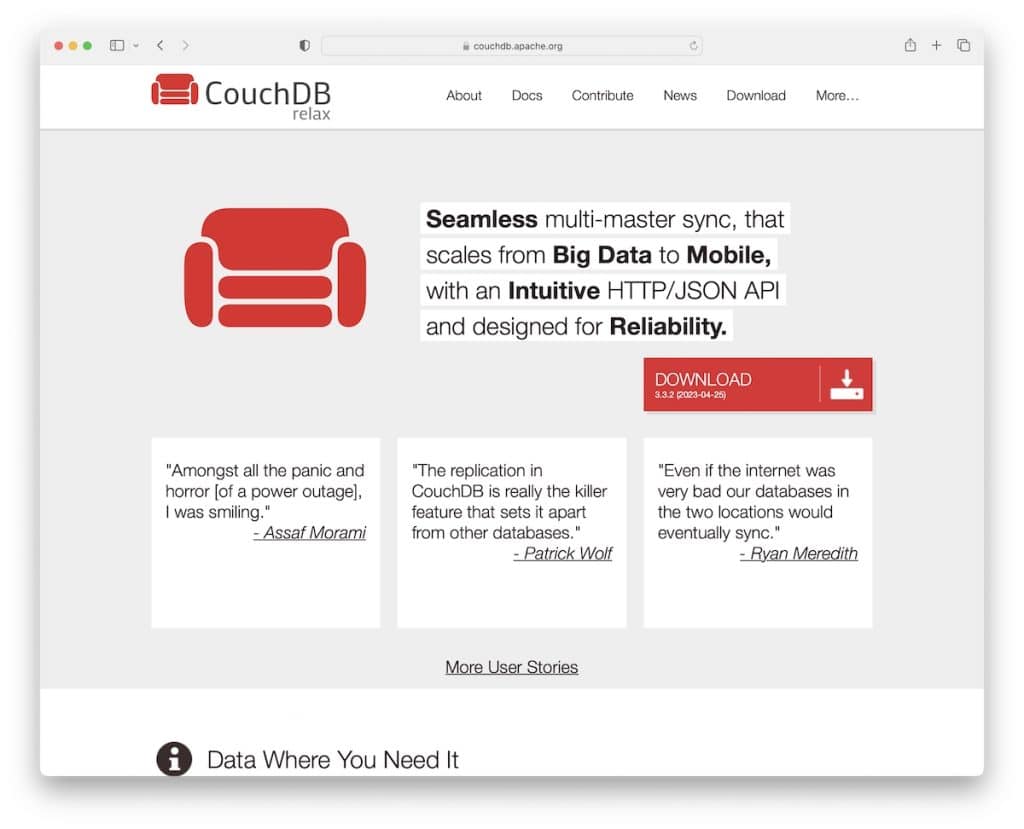
CouchDB stores your data safely and makes it effortlessly accessible across various environments – from server clusters to mobile phones and web browsers.
It speaks the language of JSON and understands binary data, making it a perfect match for both web and native applications.
What’s cool about CouchDB is its replication protocol. It allows your data to flow seamlessly, ensuring a fantastic offline-first experience.
This means your applications can perform splendidly even when the internet plays hide and seek, maintaining high performance and reliability.
CouchDB isn’t just a one-trick pony; it’s incredibly versatile. Starting as a single-node database, it’s perfect for smaller projects. Still, as your needs grow, CouchDB grows with you, quickly scaling up to a clustered database for higher capacity and availability.
For those who care about data reliability (and who doesn’t?), CouchDB takes this seriously. Its crash-resistant structure and redundant data saving across a multi-node cluster mean your data is always safe and sound.
Key Features of CouchDB:
- Data access across various computing environments, including server clusters, mobile phones, and web browsers.
- It speaks JSON natively and supports binary data, making it compatible and efficient for web and native apps’ data storage needs.
- User-friendly query language and optional MapReduce for efficient and comprehensive data retrieval.
- CouchDB ensures compatibility with other software and external tools like HTTP proxy servers and load balancers.
- The database’s unique Replication Protocol lays the foundation for new generations of “Offline First” applications.
Best for:
CouchDB takes care of your small apps or large-scale projects. It’s a flexible and reliable database solution for applications that require seamless data synchronization across various environments, including web, mobile, and server clusters.
Pricing: CouchDB is free and open-source.
Get CouchDB
9. Firebird
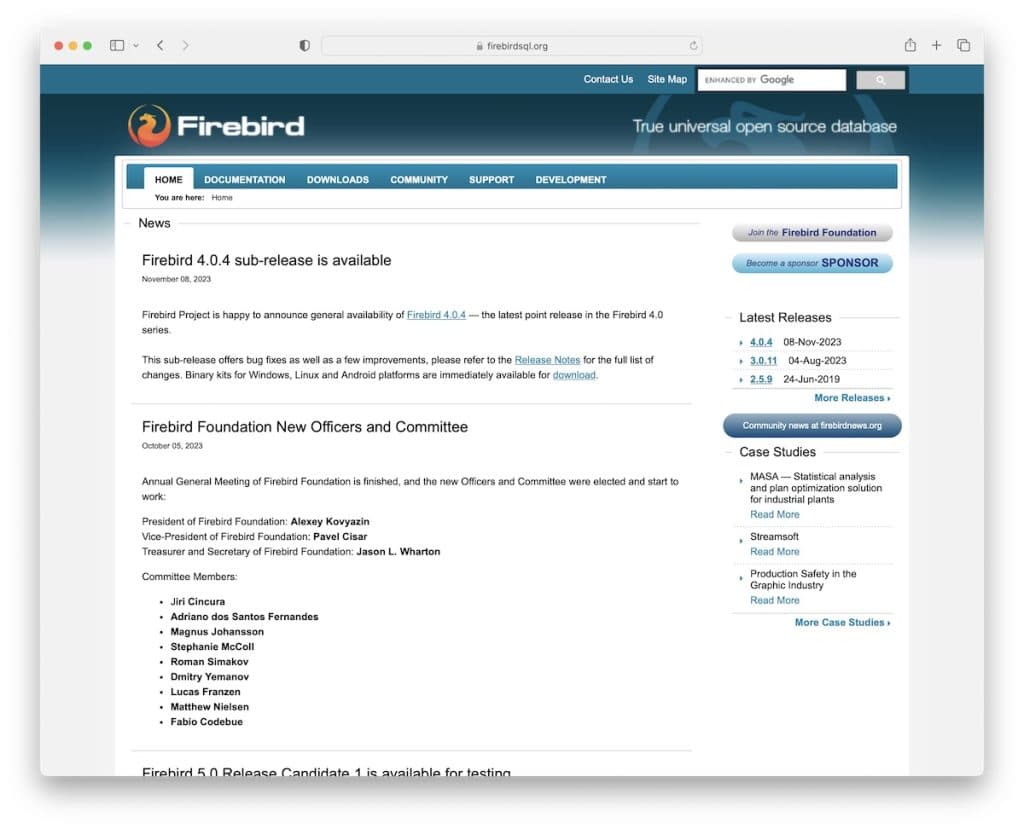
Firebird is a hidden gem in the open-source relational database world.
It’s a tool that handles multiple hefty databases and 100s of simultaneous clients without a hitch.
Firebird works with many platforms and operating systems, including Windows, Linux, and MacOS. Plus, it’s super easy to migrate between these platforms.
The heart of Firebird’s magic lies in its multi-generational architecture. It can multitask, simultaneously serving as an analytical and operational data store for smoother data handling. This is especially crucial in hybrid OLTP and OLAP applications where data consistency is vital.
It also supports everything from stored procedures and triggers to common table expressions and cross-database queries. For the security-conscious, Firebird ensures peace of mind with robust features like standard security, Windows Trusted Authentication, and secure network protocols.
Firebird has plenty of tools and connectivity options, making it a dream to work with. Whether you’re coding in Java, PHP, or Delphi, Firebird is right there with you.
Last but not least, it’s super lightweight, so you don’t need a supercomputer to run it.
Key Features of Firebird:
- Firebird excels from an embedded, single-user model to large enterprise deployments. It can handle multiple terabyte-size databases and hundreds of simultaneous clients.
- Compatibility with a range of hardware ensures easy migration and broad accessibility.
- It offers standard security features, Windows Trusted Authentication, and network security with a configurable single network port.
- Supports databases up to 20 terabytes, demonstrating significant performance and scalability.
Best for:
Firebird suits small embedded systems to large enterprise applications. Its cross-platform support, advanced SQL features, and robust security make it ideal for various development scenarios.
Pricing: Firebird is free and open-source.
Get Firebird
10. MongoDB
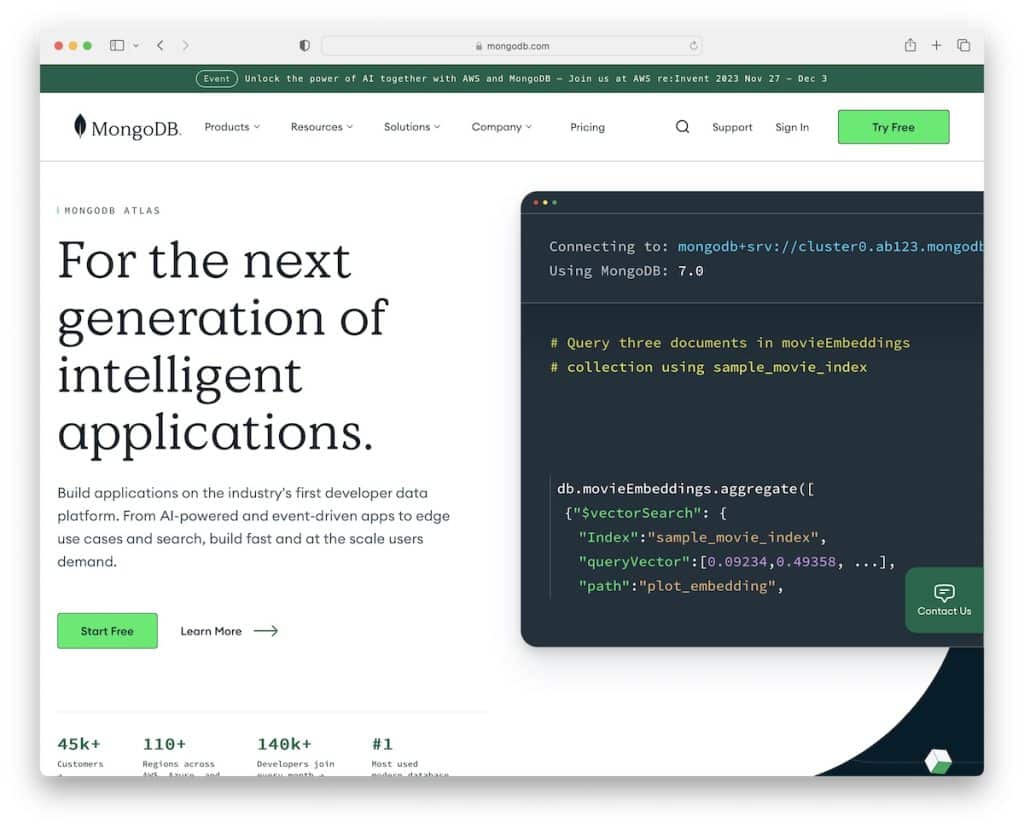
MongoDB offers unparalleled data distribution and mobility across AWS, Azure, and Google Cloud.
Atlas is the heart of its charm, an integrated suite of data services that makes your life easier and your build faster.
Whether you’re a developer in a startup or a data wizard in a large enterprise, MongoDB Atlas is like your personal data concierge. It handles all the tricky stuff so you can focus on creating magic with your data.
Scaling your operations? MongoDB Atlas has your back with automated best practices and intelligent operations management. Plus, it lets you run your applications anywhere in the world, in over 90 regions.
And when it comes to simplifying your architecture, MongoDB equips you with a unified query API that plays nicely with full-text search, analytics, and visualizations.
Key Features of MongoDB:
- It offers a comprehensive suite of data services designed to simplify and accelerate application development with data.
- MongoDB Atlas automates critical operations and incorporates built-in best practices to ensure data security and optimal database performance.
- The unified query API allows easy data access and querying for various use cases.
- It offers serverless and elastic deployment options to scalable operations that adapt to the usage. (It only charges for the resources utilized.)
Best for:
MongoDB is for those who require a scalable, cloud-native database that excels in managing complex, diverse data across multiple cloud platforms. Its robust features and global deployment capabilities work best for high-availability, real-time analytics applications.
Pricing: MongoDB offers a limited free plan that supports 512MB to 5GB of storage. You can also opt for Serverless and Dedicated packages for $0.10/million reads or $57+/month.
Get MongoDB
11. CockroachDB

What’s truly unique about CockroachDB is how it handles growth without the pain of sharding. It expands your database capacity seamlessly, keeping everything running smoothly as your user base grows.
And outages? Practically a thing of the past! CockroachDB brings downtime to near zero, ensuring every user stays smiling.
The real game-changer is its global deployment capabilities. Whether dealing with data regulations or chasing low latency, CockroachDB lets you instantly deploy anywhere in the world.
For the developers out there, CockroachDB speaks your language with its Postgres-compatible SQL syntax. Plus, you’re set up for success with free tutorials, courses, and round-the-clock expert support.
And if you’re looking for hassle-free management, CockroachDB’s fully managed service does the trick. Pay only for what you use, scale automatically, and make schema changes online without a hitch.
Dive into the world of CockroachDB and experience the freedom to build, scale, and innovate without limits.
Key Features of CockroachDB:
- Effortless scaling from a single instance to massive deployments makes it ideal for growing applications.
- It offers robust fault-tolerance and minimizes downtime, aiming for zero Recovery Point Objective (RPO) and Recovery Time Objective (RTO).
- Supports instant deployment anywhere globally, optimizing for low-latency data access and compliance with regional regulations.
Best for:
CockroachDB is for developers and organizations requiring a scalable, resilient, and globally distributed database for high-traffic, dynamic applications.
Pricing: CockroachDB is free and open-source. But there’s also a Dedicated solution at $295/month and a Self-Hosted one with pricing upon request.
Get CockroachDB
What Is The Best Open-Source Database Software
If you’re still unsure about which tool to use for your database needs, our ultimate three choices are:
- MySQL stands out for its remarkable user-friendliness and efficiency. It’s ideal for various applications, from small personal projects to large-scale enterprise systems. Its robust security, high performance, and scalability ensure it can easily handle complex data management tasks.
- MariaDB distinguishes itself with its open-source commitment and community-driven enhancements, offering advanced performance over MySQL, especially in speed and efficiency. Its compatibility ensures seamless migrations while providing unique features like a broader range of storage engines and enhanced query capabilities.
- PostgreSQL is renowned for its advanced data management capabilities and ACID-compliant transactions. It’s highly reliable for complex and large-scale database applications. Also, it supports a wide range of data types, including JSON and geospatial data, along with powerful indexing and query capabilities.
How To Get Started With MySQL
1. Download MySQL:
- Visit the MySQL official website.
- Choose the version suitable for your operating system (Windows, Linux, MacOS).
- Download the MySQL Community Server, which is the free, open-source version.
2. Install MySQL:
- Run the installer you downloaded.
- Follow the installation wizard’s steps, choosing the default settings if unsure.
- Set a root password when prompted during the installation process.
3. Verify MySQL Installation:
- Open your command line tool (Command Prompt on Windows, Terminal on MacOS/Linux).
- Type mysql -u root -p, then enter the root password you set during installation.
- If you see the MySQL shell, the installation is successful.
4. Create a Database:
- In the MySQL shell, create a new database using CREATE DATABASE your_database_name;.
5. Create a User and Grant Privileges:
- Create a new user using CREATE USER ‘username’@’localhost’ IDENTIFIED BY ‘password’;.
- Grant privileges to this user on your database using GRANT ALL PRIVILEGES ON your_database_name.* TO ‘username’@’localhost’;.
- Apply the changes with FLUSH PRIVILEGES;.
6. Start Using MySQL:
- You can now start creating tables and inserting data into your new database.
- Use USE your_database_name; to select your database.
- Begin exploring SQL commands to create tables, insert data, and query your database.
7. Learn and Explore:
- Consult the MySQL documentation for detailed guides and tutorials.
- Experiment with different SQL queries to understand how the database responds.
- Practice is key to mastering MySQL, so keep experimenting and learning.
Further reading:
Frequently Asked Questions (FAQs)
What is open-source database software?
Open-source database software is a database management system where the source code is freely available for use, modification, and distribution.
How does open-source database software differ from proprietary software?
Unlike proprietary software, open-source database software allows users to access and modify the code, offering more flexibility and community-driven improvements.
Can open-source database software scale for large businesses?
Yes, many open-source databases like PostgreSQL and MongoDB are designed for scalability and can handle the demands of large businesses.
Is open-source database software secure?
Open-source databases can be very secure. Regular updates and a large community of developers contribute to their security, but it’s crucial to implement proper security measures.
Does open-source mean the software is free?
Most open-source software is free, but some may have costs associated with support, additional features, or enterprise versions.
What are some popular open-source database software examples?
Popular examples include MySQL, PostgreSQL, MongoDB, and SQLite.
Can I use open-source database software for commercial purposes?
Yes, open-source database software can generally be used for commercial purposes. But it’s important to check each software’s specific licensing terms.
How do I choose the right open-source database for my project?
Consider factors like the size and complexity of your data, scalability needs, community support, and specific features like data types and indexing capabilities.
Can I contribute to an open-source database software project?
Yes, open-source projects often welcome contributions ranging from code to documentation, depending on your skills and interests.
Was this article helpful?
YesNo
[ad_2]
Source link
